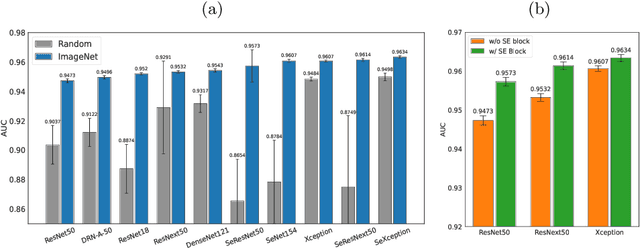Nahid Ul Islam
Foundation X: Integrating Classification, Localization, and Segmentation through Lock-Release Pretraining Strategy for Chest X-ray Analysis
Mar 12, 2025Abstract:Developing robust and versatile deep-learning models is essential for enhancing diagnostic accuracy and guiding clinical interventions in medical imaging, but it requires a large amount of annotated data. The advancement of deep learning has facilitated the creation of numerous medical datasets with diverse expert-level annotations. Aggregating these datasets can maximize data utilization and address the inadequacy of labeled data. However, the heterogeneity of expert-level annotations across tasks such as classification, localization, and segmentation presents a significant challenge for learning from these datasets. To this end, we introduce nFoundation X, an end-to-end framework that utilizes diverse expert-level annotations from numerous public datasets to train a foundation model capable of multiple tasks including classification, localization, and segmentation. To address the challenges of annotation and task heterogeneity, we propose a Lock-Release pretraining strategy to enhance the cyclic learning from multiple datasets, combined with the student-teacher learning paradigm, ensuring the model retains general knowledge for all tasks while preventing overfitting to any single task. To demonstrate the effectiveness of Foundation X, we trained a model using 11 chest X-ray datasets, covering annotations for classification, localization, and segmentation tasks. Our experimental results show that Foundation X achieves notable performance gains through extensive annotation utilization, excels in cross-dataset and cross-task learning, and further enhances performance in organ localization and segmentation tasks. All code and pretrained models are publicly accessible at https://github.com/jlianglab/Foundation_X.
Seeking an Optimal Approach for Computer-Aided Pulmonary Embolism Detection
Sep 15, 2021



Abstract:Pulmonary embolism (PE) represents a thrombus ("blood clot"), usually originating from a lower extremity vein, that travels to the blood vessels in the lung, causing vascular obstruction and in some patients, death. This disorder is commonly diagnosed using CT pulmonary angiography (CTPA). Deep learning holds great promise for the computer-aided CTPA diagnosis (CAD) of PE. However, numerous competing methods for a given task in the deep learning literature exist, causing great confusion regarding the development of a CAD PE system. To address this confusion, we present a comprehensive analysis of competing deep learning methods applicable to PE diagnosis using CTPA at the both image and exam levels. At the image level, we compare convolutional neural networks (CNNs) with vision transformers, and contrast self-supervised learning (SSL) with supervised learning, followed by an evaluation of transfer learning compared with training from scratch. At the exam level, we focus on comparing conventional classification (CC) with multiple instance learning (MIL). Our extensive experiments consistently show: (1) transfer learning consistently boosts performance despite differences between natural images and CT scans, (2) transfer learning with SSL surpasses its supervised counterparts; (3) CNNs outperform vision transformers, which otherwise show satisfactory performance; and (4) CC is, surprisingly, superior to MIL. Compared with the state of the art, our optimal approach provides an AUC gain of 0.2\% and 1.05\% for image-level and exam-level, respectively.
 Add to Chrome
Add to Chrome Add to Firefox
Add to Firefox Add to Edge
Add to Edge